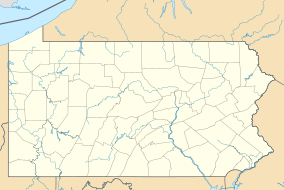Hoverter and Sholl Box Huckleberry Natural Area
| Hoverter and Sholl Box Huckleberry Natural Area | |
|---|---|
Map of Pennsylvania | |
| Location | Perry County, Pennsylvania |
| Nearest town | New Bloomfield |
| Coordinates | 40°24′22″N 77°10′26″W / 40.40611°N 77.17389°W |
| Area | 10 acres (4.0 ha) |
| Designated | 1967 |
Hoverter and Sholl Box Huckleberry Natural Area is a 10-acre (4.0 ha) natural area in Perry County, Pennsylvania, near New Bloomfield, which protects a colony of box huckleberry over 1,000 years old.[1][2] The smallest Natural Area in Pennsylvania,[3] it is administered as part of Tuscarora State Forest.[2] It was designated a National Natural Landmark in April 1967.[4]
Topography
[edit]A 0.25-mile (0.40 km) path forms a loop around the site, which is located on the west side of a hill slope.[3] Twenty-seven interpretive stations are located along the trail.[1] In addition to the low growth of the box huckleberry itself, the hillside is covered with white pine and oak forest, with a scattering of other trees and various wildflowers.[3]
History
[edit]The specimen of box huckleberry at the natural area has been estimated, based on its observed rate of growth and clonal reproduction, to be 1,200[5] to 1,300 years old,[1] only a tenth of the estimated age for a nearby colony at Losh Run.[6] The colony was discovered by Spencer Baird in 1845.[7] No specimens of box huckleberry had been collected since 1805, and Baird's discovery allowed Asa Gray to classify the species as Gaylussacia brachycera.[8] The resulting correspondence sparked a lifelong friendship between the two, and helped Baird attain a post at the Smithsonian Institution.[5]
The box huckleberry remained largely obscure until 1918, when Frederick V. Coville examined the site. On the basis of his observations there, he concluded that box huckleberry was self-sterile and spread clonally. After commercial nurserymen removed a truckload of plants from the site, Coville called attention to its plight with an article in Science.[5] Renewed interest sparked the discovery of other box huckleberry colonies elsewhere in the Appalachians.[9]
The New Bloomfield site was first protected with the donation of 4 acres (1.6 ha) to the state in 1929, the beginning of the Natural Area.[3]
References
[edit]- ^ a b c Crable, Ad (1999-08-20). "Meet The World's Oldest--and Hardest Working--Plant". Lancaster New Era. Archived from the original on 2008-05-29. Retrieved 2008-06-22.
- ^ a b "Tuscarora State Forest Natural Areas". Pennsylvania Department of Conservation and Natural Resources. Archived from the original on February 26, 2004. Retrieved 2008-08-13.
- ^ a b c d Fergus, Charles; Rae, Rusty (January 2002). Natural Pennsylvania: Exploring the State Forest Natural Areas. Stackpole Books. p. 48. ISBN 978-0-8117-2038-0.
- ^ "Box Huckleberry Site". nps.gov. National Park Service. Archived from the original on 2013-03-08. Retrieved 2013-03-30.
- ^ a b c Coville, Frederick V. (1919-07-11). "The Threatened Extinction of the Box Huckleberry, Gaylussacia brachycera". Science. 50 (1280): 30–34. doi:10.1126/science.50.1280.30. JSTOR 1641999. PMID 17801660. Archived from the original on 2021-05-09. Retrieved 2019-07-06.
- ^ Wherry, Edgar T. (June 1972). "Box-Huckleberry as the Oldest Living Protoplasm". Castanea. 37 (2). Southern Appalachian Botanical Society: 94–95. JSTOR 4032456.
- ^ Smith, Hazel; Smith, Don (June 1971). "The Box Huckleberry, Gaylussacia brachycera". Castanea. 36 (2). Southern Appalachian Botanical Society: 81–89. JSTOR 4032308.
- ^ Pooler, Margaret; Nicholson, Rob; Vandegrift, Andrew (2008). "Clonal Fidelity in Large Colonies of Gaylussacia brachycera Gray (Box Huckleberry) Assessed by DNA Fingerprinting". Northeastern Naturalist. 15: 67–74. doi:10.1656/1092-6194(2008)15[67:CFILCO]2.0.CO;2. ISSN 1092-6194. Retrieved 2008-06-21.
- ^ Wherry, Edgar T. (February 1934). "The box huckleberry as an illustration of the need for fieldwork". Bulletin of the Torrey Botanical Club. 61 (2). Torrey Botanical Society: 81–84. doi:10.2307/2480787. JSTOR 2480787.


